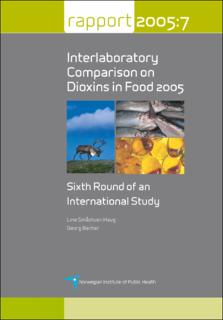| dc.description.abstract | In 2005, the sixth round of Interlaboratory Comparison on Dioxins in Food was conducted on the determination of the 2,3,7,8-chlorinated dibenzo-p-dioxins (PCDDs) and dibenzofurans (PCDFs) as well as dioxinlike non-ortho and mono-ortho chlorinated biphenyls (PCBs) in three different food items. In this round, also polybrominated diphenyl ethers (PBDEs) as well as the six indicator PCBs could voluntarily be determined and reported. The objectives were a) to offer a quality assurance instrument for the participating laboratories, b) to assess the between laboratory reproducibility and c) to assess the readiness of expert laboratories worldwide to determine levels of chlorinated and brominated persistent organic pollutants in regular foodstuffs.
The 2005 study was performed on sample homogenates of reindeer meat, herring filet and cod liver oil. In addition, five standard solutions were provided containing known concentrations of a) PCDDs/PCDFs, b) non-ortho PCBs, c) mono-ortho PCBs, d) PBDEs, and e) indicator PCBs. The testing materials were sent to 95 laboratories in February 2005, and results were returned from 87 laboratories in 28 different countries by the deadline in May. Most laboratories participated in all of the three food items. A draft report was made available on the Internet in July and was discussed among the participants at a consultation meeting during the Dioxin 2005 Symposium in Toronto, Canada.
This report presents all of the results reported from the participating laboratories for the 29 analytes assigned a toxic equivalency factor (TEF) by the WHO in 1998: all seventeen 2,3,7,8-substituted PCDDs and PCDFs, the non-ortho substituted PCBs #77, 81, 126 and 169, and the eight mono-ortho substituted PCBs #105, 114, 118, 123, 156, 157, 167, 189, in the three food items on a fresh weight basis. In addition, the results for eight PBDE congeners BDE #28, 47, 99, 100, 153, 154, 183 and 209 and six indicator PCB congeners PCB #28, 52, 101, 138, 153 and 180 were reported from those laboratories that voluntarily determined their concentrations. Assigned values for the analytes were determined by the participant consensus technique. Non-detected congeners were assigned a concentration corresponding to the reported detection limit except for PBDEs and indicator PCBs where nondetects were removed from the data set. The consensus concentration for each analyte in the three food samples was determined as follows: The median of all reported concentrations for each analyte was calculated. All values above two times the median were then removed from the calculation. The consensus median and consensus mean plus standard deviation were calculated from the remaining data. Toxic equivalents (TEQs) were calculated from the consensus values of individual congeners using the toxic equivalency factors derived by WHO in 1998. Z-scores for PCDD/ PCDF TEQs were calculated for each laboratory using a deviation of ±20% of the consensus TEQs. Further, z-scores were calculated for the non-ortho PCB TEQ, the mono-ortho PCB TEQ, the total TEQ, the sum of six indicator PCBs, the sum of seven PBDEs and for each singel congener in all three matrixes.
The consensus values for the standard solutions were calculated in the same manner except that values outside ± 50% of the median of all values were removed prior to final calculation of the consensus median and mean. The consensus values for the lipid content were calculated by first excluding results deviating more than two standard deviations from the mean of all values and then re-calculating the median, mean and standard deviation.
For the determination of PCDDs/PCDF TEQs, zscores within ±1 were obtained by 62-86% of the laboratories. The majority of the laboratories (88 to 95%) reported results for PCDD/PCDFs with an acceptable trueness (±40%) for all food samples. Also the RSD´s calculated for the total TEQ after removal of outliers are quite low (10 to 13%). It is therefore concluded that the performance of laboratories world-wide in determining dioxin-like compounds is generally good for food samples with elevated contamination levels.
Thirtyeight laboratories reported concentrations for the seven tetra- to hepta-BDEs and 62 laboratories reported results of the six indicator PCBs. The sum of the PBDE concentrations ranged from 37 pg/g fresh weight in reindeer to 14 ng/g fresh weight in cod liver oil. The RSD for PBDE concentrations on fresh weight basis was on average 29%, 31% and 44% for cod liver oil, herring and reindeer, respectively. The consensus concentrations calculated for BDE-209 are just indicative values as only few laboratories had reported this congener. The sum of concentrations for indicator PCBs were 1.1, 7.5 and 84 ng/g fresh weight for reindeer, herring and cod liver oil, respectively. The corresponding average RSDs were 36%, 28% and 27%. | |
